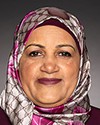Good morning, and thank you, Madam Chair.
Boozhoo. Aaniin.
As-salaam alaikum. Ramadan kareem to my Muslim colleagues in this space and beyond.
We are on traditional territory that the Algonquin peoples have called home for generations upon generations.
This is my first time meeting with you in this room. I'm thankful to be here to speak with you about the main estimates and how they're going to allow Women and Gender Equality to better implement the mandate that it has been given.
As you know, the focus of our government on advancing gender equality is based on two premises. One, it's the right thing to do. It's the fair thing to do. Two, it's also the smart thing to do. It's the economically advantageous thing to do. When women succeed, everyone benefits.
That pillar, our gender equality pillar, has been a big driver for economic growth for us since we formed government. This plan that we've put together is working: one million jobs, the lowest poverty rate on record and the lowest unemployment rate we've had in over four decades. We have lifted out of poverty 300,000 children who are not going to bed hungry anymore. Also, we've been able to sign three trade agreements. This is all a sign that our plan is working.
I want to thank the members of this committee for your important work. When you collaborated and you worked together, you had tremendous results. As the minister responsible for this file, I tell the stories, especially around gender-based violence, of how you came together and how you made a world of difference for a lot of people. You've eased a lot of suffering, for example, with the conversations you had with Facebook around revenge porn.
When women have choices, when they have a voice, opportunity and the right skills, when they have safety, and when they have role models and social safety nets, they move mountains. Every single one of us knows women in our lives—and those women are around this table as well—who are able to do big things because of those choices, opportunities and means.
Our government has worked to apply an intersectional gendered lens throughout everything we do and every decision in cabinet. Now it's the law to apply that lens to budgets. More and more, we're seeing committees do a really good job of that. There are still some inconsistencies around the application of GBA+, but we intend to make sure that we get better.
I do want to thank my parliamentary secretary, Terry Duguid, who has been working very hard with other parliamentary secretaries to make sure that the GBA+ is something that committees apply as well.
The Canada child benefit is giving more money to single moms and helping them make ends meet. The lower taxes for the middle class and the raised taxes for the 1%, along with lower taxes for small businesses, mean that Canadians have more money in their pockets. For seniors, especially for women—I know you've done a study on this—the guaranteed income supplement and the fact that we brought the eligibility age back to 65 is lifting tens of thousands of seniors out of poverty, many of whom are women.
There's the national housing strategy, with over $50 billion now over 10 years to stabilize the housing market in communities across the country. In Peterborough, my own community, the rental vacancy rate is 1.1%. We know that women are the first to lose housing and the last to get housing.
We know that housing is a social determinant of health, but it's also a determinant of gender-based violence. To have a carveout in the gender-based violence strategy—about a third—designed specifically for women-led families is a solution that's going to make a world of difference. There are 7,000 shelter units either being renovated or built anew. That's going to mean that she has a place to turn to when she works up the courage to leave an awful situation.
If we're applying an intersectional gendered lens, talking about feminist governments and working to ensure that we bring others along with us, it's because there has been a women's movement, an equality-seeking movement, that existed long before any of us got here. It will be here long after we're gone. The sustainability of that movement is my number one priority; we know, and results show, that the most effective way to advance gender equality is by investing in them.
For the first time ever, they've received funding over five years, capacity-building funding, with over $50 million as part of the gender-based violence strategy. The point here is that they don't always have to look inward, applying for grants one year at a time. They can have some predictability and stability with five-year grants that go beyond an election cycle.
We also know there are barriers for those women who choose to enter STEM fields, or trades. We're working to remove them. We know that only 16% of Canadian entrepreneurs' businesses are majority-owned by women—16%. Surely we can do better than that in Canada. We have a strategy to double that number by 2025.
We know that care work is most often a big responsibility for women. What if that responsibility and privilege were shared with the second parent, often the father? We have new shared parental leave that allows for just that. Child care is very much in line with that. Our investment in child care means there will be at least 40,000 new child care spaces. Importantly, there are spaces, through a distinctions-based approach, for indigenous children. We have a new child care framework for indigenous kids—Métis, Inuit and first nations. That's been a smart collaboration between our governments in a nation-to-nation way.
Over half the boil water advisories have been lifted, and we know there's a direct link between women and water. We know that in indigenous cultures and in many others women are the keepers of the water. Water is sacred; water is life. To have lifted half the advisories and be on track to lift the rest of them by 2021—in the next two years—is a big step forward. What that means for those communities, too, is that they suddenly become open for economic development. It's hard to invest if there's no clean drinking water in a community, but we're changing that.
Evidence matters. Data matters, so bringing back the census, and the ability of scientists to do what they need to do.... For example, the shelter survey results from a couple of weeks ago indicated where the gaps and opportunities are. Also, the fact that Stats Canada has a centre for diversity and inclusion statistics, a one-stop shop for all the data we're working on, to create better intersectional, gendered lenses, is really important. That's something that stays long after we're gone. Data and evidence anchor the progress we have made.
The billions we are providing to support education, infrastructure, skills, housing and leadership in indigenous communities mean that we are in this era of reconciliation and that we will not be turning back. Communities have more opportunities to self-determine the paths they want to take.
These accomplishments are significant, and many of them have been happening ahead of schedule—for example, the indexation of the Canada child benefit, not once, but twice, and the lifting of people out of poverty. We are ahead of schedule, with one million jobs. Who would have thought, when we formed a government in a recession, that we'd be talking about a million jobs and three trade agreements three years later? This is happening because our government isn't alone, but is working with our partners to do this.
We know that for all the progress that's been made, more work remains, and we're committed to that work. There are some institutional challenges that we're working to address. The fact that GBA+ is now in law for gender budgeting is an important way that we're addressing some systemic barriers.
Indeed, we are taking that diversity lens to the appointments that the federal government makes, and we have instituted a new appointment process. Thousands have been appointed to really important roles in federally regulated jurisdictions. Now, 47% of those who sit around those important tables, and who make decisions, whether it's port authorities, VIA rail or other important agencies and bodies, are women. The Senate of Canada is also at parity right now, at a time when on corporate boards in Canada, only one in five seats is filled by a woman. Again, surely we can do better in Canada.
We have a gender results framework that provinces and territories have agreed to use with us—a common set of indicators to measure our progress. We have proactive pay equity legislation, Bill C-65 and Bill C-51.
Of course, come June 3, the inquiry on missing and murdered indigenous women wraps up its work.
I wanted to give you an overview. Thank you again for all the ways you've been a part of this work.
Madam Chair, I'm happy to take any questions colleagues may have.






